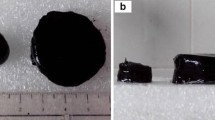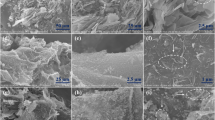Abstract
The synthesis of a nanocomposite material based on graphene modified with iron oxide nanoparticles, which is an effective sorbent of organic pollutants contained in aqueous media, has been considered. The production of graphene by chemical reduction of graphene oxide (GO) is the most flexible and popular method for the synthesis of composite materials of various structures based on graphene. Chemical reduction of graphene oxide was carried out using gamma-lactone-2,3-dehydro-L-gulonic acid (ascorbic acid). The method of obtaining the composite under study includes processing the hydrogel obtained after the GO reduction in supercritical isopropanol, which makes it possible to obtain graphene aerogel containing nanoparticles of iron(II, III) oxide. The analysis of the specific surface and porosity of the obtained aerogel showed that the specific surface area of the aerogel was ~7 times higher as compared to the specific surface of the xerogel obtained by drying of the hydrogel under ordinary conditions in air. The diffractometric analysis of xerogel and aerogel samples suggests that, during supercritical drying in the organic fluid, the processes of iron hydroxide reduction to iron(II, III) oxide proceed. The sorption capacity of the obtained hydro- and aerogel was studied by the extraction of methylene blue organic dye from aqueous solutions in a static mode (batch method). The results of the experiments showed that the maximum values of the sorption capacity for the methylene blue dye were 1370 and 1326 mg/g for the hydro- and aerogel, respectively.





Similar content being viewed by others
REFERENCES
Liang, L., Zhou, M., Li, K., and Jiang, L., Facile and fast polyaniline-directed synthesis of monolithic carbon cryogels from glucose, Microporous Mesoporous Mater., 2018, vol. 265, pp. 26–34.
Narayanan, K.B., Choi, S.M., and Han, S.S., Biofabrication of Lysinibacillus sphaericus-reduced graphene oxide in three-dimensional polyacrylamide/carbon nanocomposite hydrogels for skin tissue engineering, Colloids Surf., B, 2019, vol. 181, pp. 539–548.
Chi, H.Z., Wu, Y.Q., Shen, Y.K., Zhang, C., Xiong, Q., and Qin, H., Electrodepositing manganese oxide into a graphene hydrogel to fabricate an asymmetric supercapacitor, Electrochim. Acta, 2018, vol. 289, pp. 158–167.
Han, B., Zhang, E., Cheng, G., Zhang, L., Wang, D., and Wang, X., Hydrothermal carbon superstructures enriched with carboxyl groups for highly efficient uranium removal, Chem. Eng. J., 2018, vol. 338, pp. 734–744.
Guilminot, E., Gavillon, R., Chatenet, M., Berthon-Fabry, S., Rigacci, A., and Budtova, T., New nanostructured carbons based on porous cellulose: elaboration, pyrolysis and use as platinum nanoparticles substrate for oxygen reduction electrocatalysis, J. Power Sources, 2008, vol. 185, pp. 717–726.
Wang, J. and Ellsworth, M.W., US Patent 20100144904, 2010.
van Hoa, N, Quyen, T.T.H., van Hieu, N., Ngoc, T.Q., Thinh, P.V., Dat, P.A., and Nguyen, H.T.T., Three-dimensional reduced graphene oxide-grafted polyaniline aerogel as an active material for high performance supercapacitors, Synth. Met., 2017, vol. 223, pp. 192–198.
Tang, G., Jiang, Z.-G., Li, X., Zhang, H.-B., Dasari, A., and Yu, Z.-Z., Three dimensional graphene aerogels and their electrically conductive composites, Carbon, 2014, vol. 77, pp. 592–599.
Babkin, A.V., Neskoromnaya, E.A., Burakov, A.E., and Burakova, I.V., Kinetics sorption of copper(II) ions from aqueous solutions with grapheme oxide, Vestn. Tambovsk. Gos. Tekh. Univ., 2018, vol. 24, no. 1, pp. 79–86.
Li, Y., Zhang, R., Tian, X., Yang, C., and Zhou, Z., Facile synthesis of Fe3O4 nanoparticles decorated on 3D graphene aerogels as broad-spectrum sorbents for water treatment, Appl. Surf. Sci., 2016, vol. 369, pp. 11–18.
Shan, S., Tang, H., Zhao, Y., Wang, W., and Cui, F., Highly porous zirconium-crosslinked grapheme oxide/alginate aerogel beads for enhanced phosphate removal, Chem. Eng. J., 2019, vol. 359, pp. 779–789.
Chen, L., Feng, S., Zhao, D., Chen, S., and Chen, C., Efficient sorption and reduction of U(VI) on zero-valent iron–polyaniline–graphene aerogel ternary composite, J. Colloid Interface Sci., 2017, vol. 490, pp. 197–206.
Yang, F., Xu, M., Bao, S.-J., Wei, H., and Chai, H., Selfassembled hierarchical graphene/polyaniline hybrid aerogels for electrochemical capacitive energy storage, Electrochim. Acta, 2014, vol. 137, pp. 381–387.
Lee, Y.J., Park, H.W., Kim, G.-P., Yi, J., and Song, I.K., Supercapacitive electrochemical performance of graphene-containing carbon aerogel prepared using polyethyleneimine-modified graphene oxide, Curr. Appl. Phys., 2013, vol. 13, no. 5, pp. 945–949.
Xu, Y., Sheng, K., Li C., and Shi, G., Self-assembled grapheme hydrogel via a one-step hydrothermal process, ACS Nano, 2010, vol. 4, no. 7, pp. 4324–4330.
Ma, T., Chang, P.R., Zheng, P., Zhao, F., and Ma, X., Porous graphene gels: preparation and its electrochemical properties, Mater. Chem. Phys., 2014, vol. 146, pp. 446–451.
Ding, M., de Jong, B.H.W.S., Roosendaal, S.J., and Vredenberg, A., XPS studies on the electronic structure of bonding between solid and solutes: adsorption of arsenate, chromate, phosphate, Pb2+, and Zn2+ ions on amorphous black ferric oxyhydroxide, Geochim. Cosmochim. Acta, 2000, vol. 64, no. 7, pp. 1209–1219.
Traina, S.J., Surface complexation modeling: hydrous ferric oxide, Geochim. Cosmochim. Acta, 1996, vol. 60, no. 21, pp. 4291–4292.
Burstein, G.T., The iron oxides: structure, properties, reactions, occurrence and uses, Corros. Sci., 1997, vol. 39, no. 8, pp. 1499–1500.
Wang, Y., Jin, Y., and Jia, M., Ultralong Fe3O4 nano-wires embedded graphene aerogel composite anodes for lithium ion batteries, Mater. Lett., 2018, vol. 228, pp. 395–398.
Long, Z., Zhan, Y., Li, F., Wan, X., He, Y., Hou, C., and Hu, H., Hydrothermal synthesis of graphene oxide/multiwalled carbon nanotube/Fe3O4 ternary nanocomposite for removal of Cu(II) and methylene blue, J. Nanopart. Res., 2017, vol. 19, p. 318.
Rosaiah, P., Zhu, J., Zhang, L., Hussain, O.M., and Qiu, Y., Synthesis of iron oxide embedded reduced grapheme oxide composites with enhanced electrochemical performance as Li-ion battery anodes, J. Electroanal. Chem., 2018, vol. 834, pp. 173–179.
Denison, M.I.J., Raman, S., Duraisamy, N., Thangavelu, R.M., Riyaz, S.U.M., Gunasekaran, D., and Krishnan, K., Preparation, characterization and application of antibody-conjugated magnetic nanoparticles in the purification of begomovirus, RSC Adv., 2015, vol. 5, no. 121, pp. 99820–99831.
Othman, N.H., Alias, N.H., Shahruddin, M.Z., Abu Bakar, N.F., Nik Him, N.R., and Lau, W.J., Adsorption kinetics of methylene blue dyes onto magnetic graphene oxide, J. Environ. Chem. Eng., 2018, vol. 6, no. 2, pp. 2803–2811.
Liu, J., Liu, G., and Liu, W., Preparation of water-soluble β-cyclodextrin/poly(acrylic acid)/graphene oxide nanocomposites as new adsorbents to remove cationic dyes from aqueous solutions, Chem. Eng. J., 2014, vol. 257, pp. 299–308.
Deng, J.-H., Zhang, X.-R., Zeng, G.-M., Gong, J.-L., Niu, Q.-Y., and Liang, J., Simultaneous removal of Cd(II) and ionic dyes from aqueous solution using magnetic graphene oxide nanocomposite as an adsorbent, Chem. Eng. J., 2013, vol. 226, pp. 189–200.
Liu, T., Li, Y., Du, Q., Sun, J., Jiao, Y., Yang, G., et al., Adsorption of methylene blue from aqueous solution by graphene, Colloids Surf., B, 2012, vol. 90, pp. 197–203.
Ramesha, G.K., Vijaya Kumara, A., Muralidhara, H.B., and Sampath, S., Graphene and graphene oxide as effective adsorbents toward anionic and cationic dyes, J. Colloid Interface Sci., 2011, vol. 361, no. 1, pp. 270–277.
Buslaeva, E.Yu., Supercritical isopropanol as a reagent in organic, organometallic, inorganic chemistry and nanotechnology, Radioelektron., Nanosist.,Inf. Tekhnol., 2012, vol. 4, no. 2, pp. 38–49.
Ivicheva, S.N., Kargin, Yu.F., and Sakharov, S.G., Manufacture of opal-matrix functional nanocomposites by catalytic dehydrogenation of isopropanol under supercritical conditions, Russ. J. Inorg. Chem., 2014, vol. 59, no. 10, pp. 1077–1086.
Gubin, S.P. and Buslaeva, E.Yu., Supercritical isopropanol as a reducing agent for inorganic oxides, Sverhkrit. Flyuidy: Teor. Prakt., 2009, vol. 4, no. 4, pp. 73–96.
Ivicheva, S.N., Kargin, Yu.F., Ashmarin, A.A., Shvorneva, L.I., and Ivanov, V.K., Nanocomposites based on opal matrices and iron subgroup metal nanoparticles, Russ. J. Inorg. Chem., 2012, vol. 57, no. 11, pp. 1419–1427.
Gubin, S.P., Supercritical hydrogen-free and catalyst-free hydrogenation: possibilities of the method, Dokl. Chem., 1995, vol. 345, nos. 4–6, p. 304.
Kargin, Yu.F., Buslaeva, E.Yu., Egorusheva, A.B., Kravchyk, G.K., and Gubin, S.P., Interaction of mixed-metal oxides with supercritical isopropanol, Russ. J. Inorg. Chem., 2003, vol. 48, no. 11, pp. 1615–1618.
Aliahmad, M. and Nasiri Moghaddam, N., Synthesis of maghemite (γ-Fe2O3) nanoparticles by thermal decomposition of magnetite (Fe3O4) nanoparticles, Mater. Sci., 2013, vol. 31, no. 2, pp. 264–268.
Bo, Z., Shuai, X., Mao, S., Yang, H., Qian, J., Chen, J., et al., Green preparation of reduced graphene oxide for sensing and energy storage applications, Sci. Rep., 2014, vol. 4, no. 4684.
De Silva, K.K.H., Huang, H.-H., Joshi, R.K., and Yoshimura, M., Chemical reduction of graphene oxide using green reductants, Carbon, 2017, vol. 119, pp. 190–199.
Zhu, X., Liu, Q., Zhu, X., Li, C., Xu, M., and Liang, Y., Reduction of graphene oxide via ascorbic acid and its application for simultaneous detection of dopamine and ascorbic acid, Int. J. Electrochem. Sci., 2012, vol. 7, pp. 5172–5184.
Dua, V., Surwade, S.P., Ammu, S., Agnihotra, S.R., Jain, S., Roberts, K.E., Park, S., Ruoff, R.S., and Manohar, S.K., All-organic vapor sensor using inkjet-printed reduced graphene oxide, Angew. Chem., Int. Ed., 2010, vol. 49, no. 12, pp. 2154–2157.
Funding
This study was financially supported by the Ministry of Education and Science of the Russian Federation (grant no. 16.1384.2017/PCh).
Author information
Authors and Affiliations
Corresponding authors
Additional information
Translated by D. Kharitonov
Rights and permissions
About this article
Cite this article
Neskoromnaya, E.A., Burakov, A.E., Melezhik, A.V. et al. Synthesis and Evaluation of Adsorption Properties of Reduced Graphene Oxide Hydro- and Aerogels Modified by Iron Oxide Nanoparticles. Inorg. Mater. Appl. Res. 11, 467–475 (2020). https://doi.org/10.1134/S2075113320020264
Received:
Revised:
Accepted:
Published:
Issue Date:
DOI: https://doi.org/10.1134/S2075113320020264




